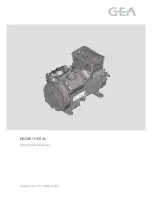
YORK INTERNATIONAL
20
FORM 220.11-NM2 (602)
Seals that are supplied from a source within the com-
pressor are commonly identified as A-1 seals. Seals in
compressors that utilize an external source of gas as a
buffer are identified as A-4 seals. Source pressure for
A-4 seals should be adjusted to the pressures defined
on the oil flow diagram for the compressor.
Atmospheric Shaft Seal (Figure 6) (Post 1970)
Refrigerant leakage along the shaft to the atmosphere
is prevented by means of a shaft seal assembly (1) which
consists of a rotating cast iron shaft seal collar (2) with
“O-ring” (3) and a stationary spring loaded carbon shaft
seal ring assembly (4), consisting of small helical
springs (5).
These springs keep the carbon shaft seal ring (6) in con-
tact with the rotating shaft seal collar (2).
The shaft seal collar (2) rotates with the shaft (positive
drive through the insert pins in the drive shaft), while
the stationary carbon seal assembly is mounted on the
shaft seal cover (7). Gaskets (8) are used to adjust the
shaft seal installation dimension. These two parts are
lubricated and cooled by the oil circulated through the
seal cavity.
Some leakage of oil and dissolved process gas is nor-
mal and does not indicate a problem. Leakage rates are
dependent upon coupling size, shaft rotational speed,
and oil reservoir/sump pressure. Larger diameter and
FIG. 6 –
EXPLODED VIEW OF ATMOSPHERIC SHAFT SEAL
higher shaft speeds will result in more leakage through
the seal faces.
Since oil leakage to the atmospheric side of the shaft
seal is collected in the drain trap, a leaking shaft seal
can be detected by a rapidly filling drain trap and a
corresponding oil level drop in the compressor oil res-
ervoir.
During operation, a small amount of oil dripping past
the seal surfaces is normal. However, if it becomes
necessary to drain the drain trap daily, the shaft seal is
leaking excessively and should be replaced.
Since the seal parts “wear in” to each other during
operation and since it is difficult to determine the
exact location of the leak, it is recommended that the
complete seal assembly (seal ring, seal collars and
“O” rings) be replaced if excessive shaft seal leak-
age occurs. The spring(s) may be reused if it is not
visibly damaged.
If a shaft seal failure occurs, the thrust bearing clear-
ance should be checked. A thrust bearing failure may
have caused the seal failure. The proper thrust clear-
ance is shown in Table 12 for each compressor size. If
a new thrust bearing is required, its clearance should
be adjusted within the limitations shown.
00621VIP
Operation
Содержание Turbomaster M 255
Страница 9: ...FORM 220 11 NM2 602 9 YORK INTERNATIONAL FIG 2 TYPICAL COMPRESSOR CROSS SECTIONAL VIEW LD07317 1...
Страница 15: ...FORM 220 11 NM2 602 15 YORK INTERNATIONAL FIG 3 TYPICAL PRIMARY COMPRESSOR GAS FLOW LD07318 3...
Страница 16: ...YORK INTERNATIONAL 16 FORM 220 11 NM2 602 FIG 4A MAJOR COMPONENTS LD07319 Operation...
Страница 31: ...FORM 220 11 NM2 602 31 YORK INTERNATIONAL Operation 3 This page intentionally left blank...
















































